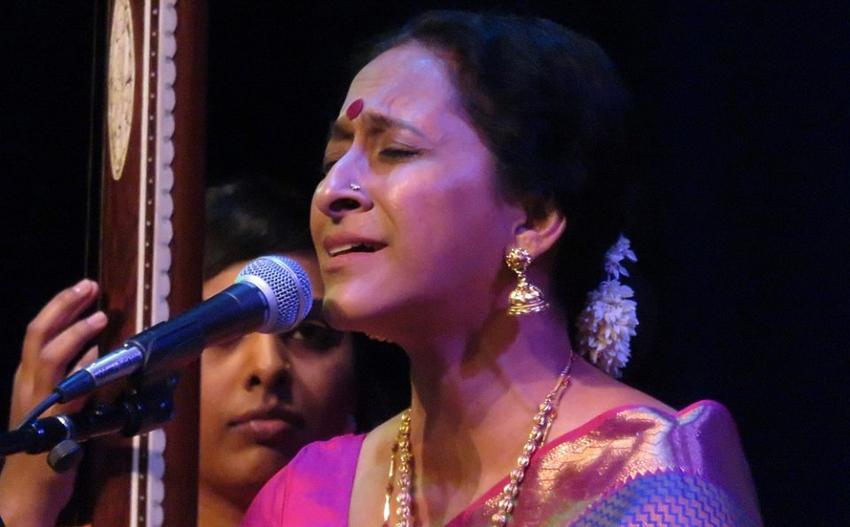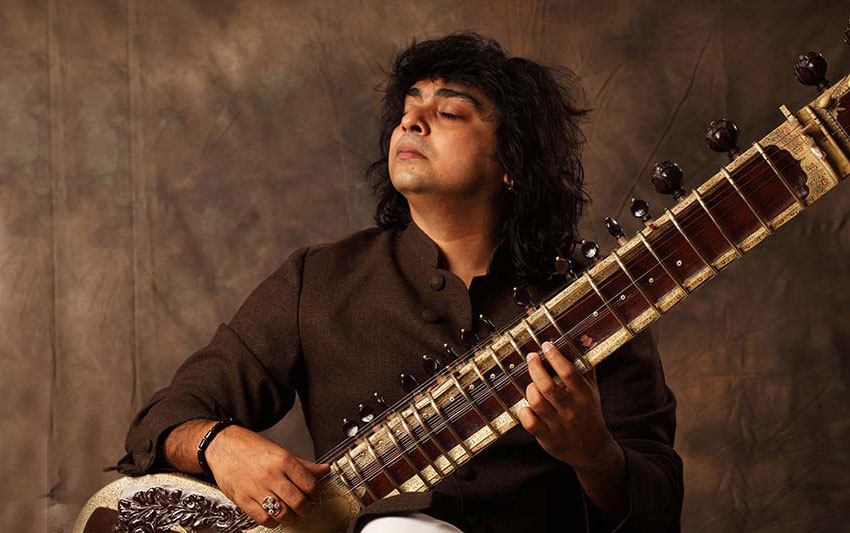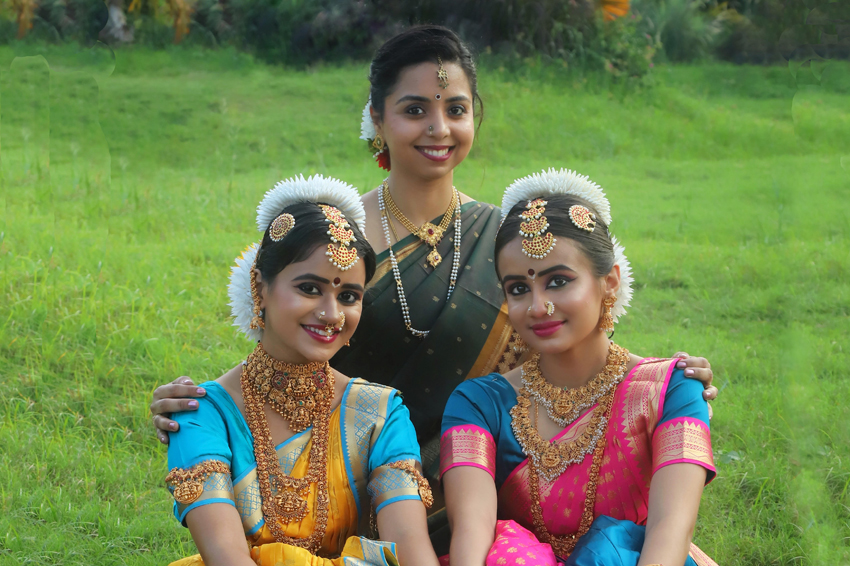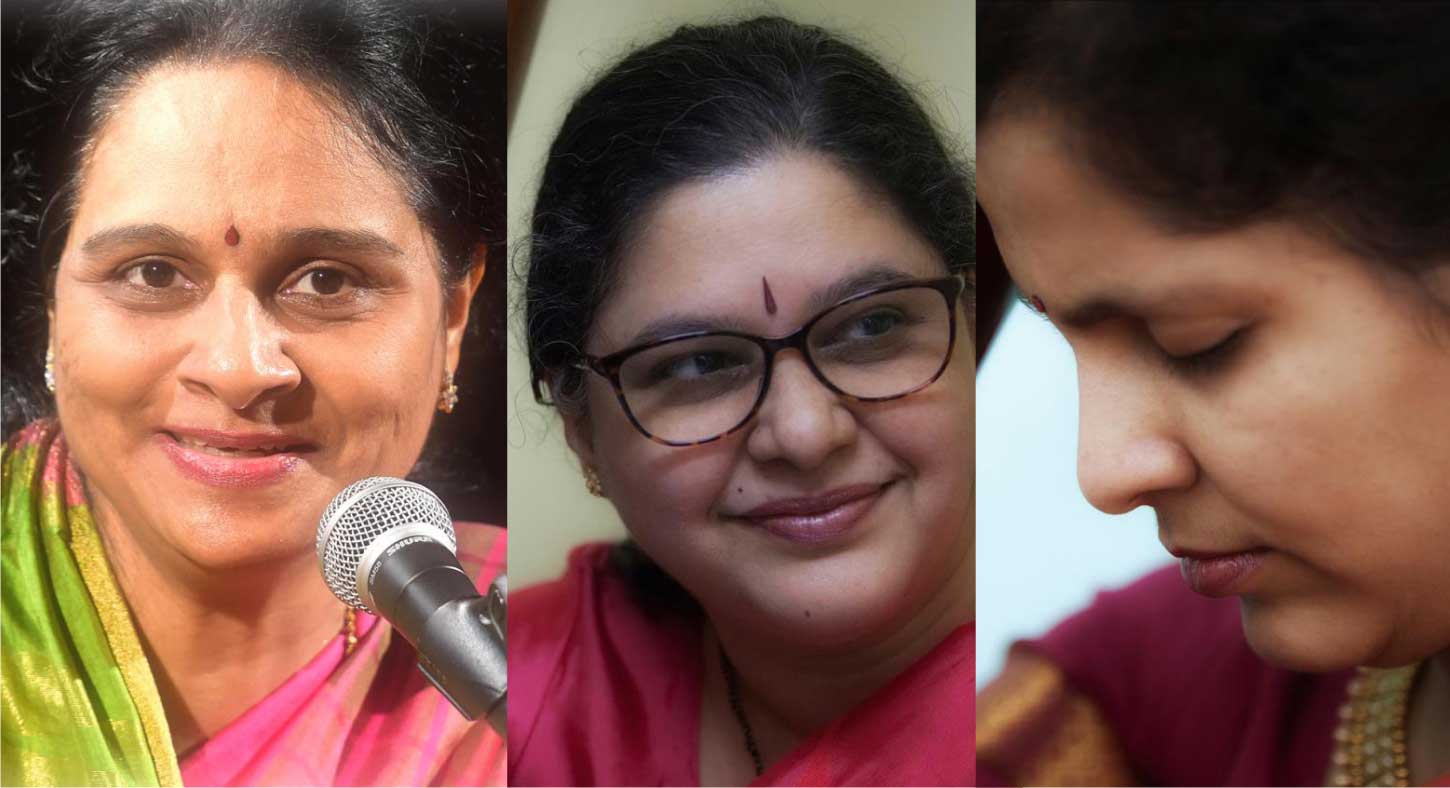Sadly, in Delhi, classical music concerts which are now a fairly regular occurrence do not usually make waves. It is quite common to see not just the 700 seater Kamani Auditorium half empty, but even smaller auditoriums with half the capacity, only half full even for senior musicians. The popularity of classical musicians in Delhi is a strange thing, not necessarily linked with their talent. Despite all concerts being free as a rule, the highly fastidious Delhi audience disdains the concerts of most musicians, reserving their favour for a select few. As such it was a very welcome change to see the overfilled Habitat Stein Auditorium at the first Morning Ragas series of the season, organized by the Indian Habitat Centre with Spic Macay last week.
Bombay Jayashri with her universal appeal was an irresistible draw which pulled her audience in despite the roads blocked outside for the marathon run. In fact, a screen had to be placed in the basement auditorium which thankfully was not booked that morning, and a further 100 or so people were accommodated there. Jayashri laughingly admitted after the concert “I did not expect to see such a large crowd so early on a Sunday morning.”
She started her concert with the relatively new to the Carnatic pantheon of Ragas, Mohan Kalyani. This is the Carnatic equivalent of Raga Shudha Kalyan, in which the subtle sparing use of shudha ni and ma in the descent distinguish it from Bhupali, or in the Carnatic nomenclature. Mohanam. Apparently there are not so many compositions in this Raga, none by the Trinity composers, Tyagaraja, Muthuswami Dikshitar and Shama Shastri, making it somewhat a speciality Raga. Jayashri’s delineation in the brief aalapam, going note by note, with minimal ‘gamakas’ was soothing and veered more towards a North Indian treatment. Jayashri is a rare artist who is able to modify her presentations of a Raga with minimal subtle deflections, giving it different flavours that one barely even perceives while listening. The composition was by Harikesanallur Muthiah Bhagavatar called ‘Bhuvaneshwariya nene maanasave’, in Kannada, set to Adi taal. As her voice soared effortlessly up the scale, there was an awed pin-drop silence in the audience.

A wonderful sense of calm, not usually associated with a Carnatic concert which tends to focus on a racier presentation, prevailed, which settled in more deeply with the next offering in Raga Khamas. The Carnatic Khamas which is a traditional old Raga with its counterpart in Khamach is hugely lyrical, but unlike Khamach in North Indian music, is treated as a serious offering. Unlike the North Indian Khamach, Khamas is presented sometimes with only the ‘shudha ni’, sometimes with both. The composition Jayashri sang was composed by Muthuswami Dikshitar in Sanskrit, ‘Santhaana Gopal Krishnam’ with both nikhads, in Rupak taal. This beautiful composition is an appeal to Lord Krishna for ‘santaan’ (offspring). Again, she preceeded the composition with a brief outline of the contours of the Raga, this time giving it a distinctly Carnatic flavor. Accompanying her expertly on the mridangam and violin was the husband-wife duo, Anantha R Krishnan and Charumathi Raghuraman; Charumathi’s solo exposition of Khamas was lovely. Despite her youth, she is definitely an artist to watch out for.
Dividing the one hour forty five minute concert expertly between the different pieces, (the time management of Carnatic artists is indeed laudable as they rarely overstep the allotted concert time), Jayashri devoted more than 40 minutes to the main piece of her presentation, which was a palliative to North Indian sensibilities, being the morning Raga Bhairav, or Mayamalavagowla. As she said “In the Carnatic system once upon a time the time theory of Ragas was adhered to. Singing in Delhi I felt I would present an evening Raga (Shudha Kalyan,) then a Raga not really bound by time (Khamach) and finally linger on the early morning Raga (Bhairav) then peter off with the afternoon Raga (Bhimpalasi) before concluding as per tradition in North India, with Bhairavi.”
Again Jayashri prefaced the composition in Telugu by Tyagaraja dedicated to Lord Rama ‘meru samana’ with an expansive delineation of the Raga. Charumathi’s brilliant interpretation during her solo veered to a more North Indian vision of the Raga; the beauty of Carnatic accompaniment, as opposed to accompaniment in the North India tradition is the freedom they enjoy. Both the violin and mridangam chart their own course, not confined to what the main artist presents, making the whole experience much richer. Jayashri’s rich embellishments during the ‘niraval’ (taking a line from the composition and giving it different musical interpretations) were a true delight.
The next Raga was Abheri (Raga Bhimpalasi) in which ‘the Nightingale of the South’ sang a Subramania Bharatiar composition in Tamil ‘vellai thamarai’. This was maybe too brief to make as much impact as it’s lyricity could have done.
She ended as always with a ‘thillana’ (equivalent in the North, tarana) created by her Guru Vidwan Lalgudi Jayaraman, in Raga Sindhu Bhairavi, again a relatively new Raga to the Carnatic pantheon. Sindhu Bhairavi is derived from Raga Bhairavi in the North Indian system which is a major Raga and called ‘sada suhagin’ as it can be sung at any time during the day or night. Jayashri explained that this composition had various facets of the Raga that her Guru had incorporated, making it a full and richly interwoven textured presentation.
[adrotate group=”9″]
Bombay Jayashri’s singing style involves a careful controlled use of the microphone using volume to bring in a different listening experience; her subtle absorption of the different music she has internalized and learnt make her presentations unique; of course firmly ensconced in the Carnatic idiom; she also has the intelligence to intuitively understand what from her staggering repertoire will best work where, and she does not always need to resort to displays of vocal virtuosity to captivate – all this combines to make her concerts a memorable experience.










